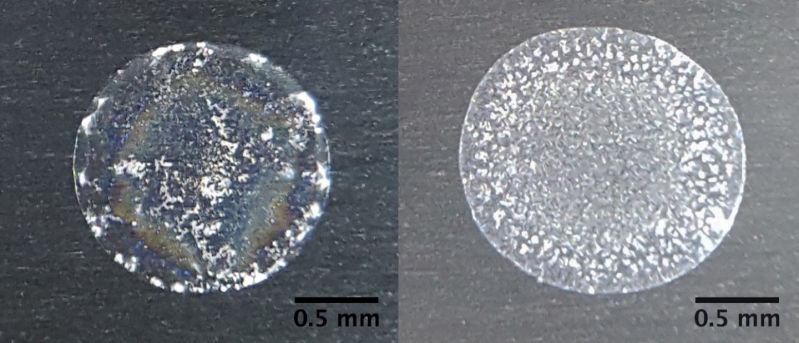‘Coffee-ring Effect’ to Provide Rapid, Low-cost Analysis of Tap Water
Published on by Water Network Research, Official research team of The Water Network in Academic
Scientists are reporting that they are using the familiar “coffee-ring effect” to analyze multiple components in a single drop of water easily, quickly and cheaply.
And someday, the public could use the method to test their own tap water.
In a nutshell, the coffee-ring effect is the familiar phenomenon in which the particles in a droplet of water tend to concentrate around the edges of the droplet as the water evaporates.

Tap water droplets from two buildings on the Michigan State University campus leave behind different coffee-ring patterns; “hard” water is shown on the left, and water treated with a softener is shown on the right.
Credit: Xiaoyan Li
“But the patterns left by the coffee-ring effect for real-world tap water samples are more intricate and unique for each water source,” says Rebecca Lahr, Ph.D. “There is a stunning amount of information there to analyze. The residue patterns for tap water are like fingerprints that can be used to identify what’s in a sample.”
Lahr points out that public health concerns only came to the fore in recent years in cities like Flint, Michigan; Washington, D.C.; Toledo, Ohio; and Charleston, West Virginia, after people consumed contaminated tap water. These experiences demonstrate the need for improved water-quality monitoring techniques, she says.
Lahr has been studying the coffee-ring effect since working on her Ph.D. thesis, originally using it to concentrate toxins in water for subsequent spectroscopic analysis.
Now, she is applying it in her lab at Michigan State University to help the public learn more about the liquid coming from their taps. It turns out that the unique pattern left by a sample of water provides information on the content and properties of the water — dissolved solids, hardness, alkalinity and metal ions, for example. Determining each of these items in a sample traditionally required a different analytical method.
The costs of those individual tests mount up. “If you are worried about your drinking water, it can be overwhelming to look at a water-testing fee schedule to decide which water tests to run,” Lahr points out. “You have to know what you are looking for beforehand.”
To conduct the coffee-ring analysis, Lahr, graduate student Xiaoyan Li, and undergraduates Selett Allen and Alyssa Sanderson dried droplets of various tap water samples on low-cost aluminum substrates. Then, they photographed the resulting coffee-ring effect with a cell phone through an inexpensive jeweler’s loupe. After many experiments, they obtained reproducible residue patterns for tap waters from communities across southern Michigan. They also created synthetic tap water solutions to mimic community tap waters with varied amounts of hardness, alkalinity, sodium, chloride, sulfate, total dissolved solids, iron and copper.
The goal, Lahr says, “is to create a library of patterns produced by the coffee ring effects for known water samples that can be used to identify the patterns from unknown samples.” She is also working on programs to automate comparison of unknown water samples to the library.
So, could the coffee-ring effect have been used to identify the problem of lead contamination of the Flint water supply? “It’s too early to say,” Lahr responds. “The idea here is to develop a faster and cheaper way to screen samples to raise red flags when there should be further analyses performed. This method won’t have the sensitivity of standard analytical techniques, but it’s much cheaper.”
She notes that the coffee-ring effect can also be used in classrooms as a way to get students excited about environmental science. “I’m amazed by how powerful it is as an educational tool,” she says. “Students bring in their own samples and quickly see the differences in the patterns left behind.”
Source: ACS
Attached link
http://www.youtube.com/embed/aC0FNVd-6fsMedia
Taxonomy
- Treatment
- Treatment Methods
- Drinking Water Treatment
- Quality
- Technology
- Water Quality
- Quality Maintenance
- Drinking Water